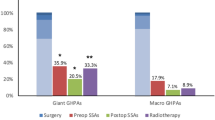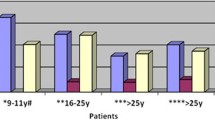Abstract
OBJECTIVE
Transsphenoidal (TNS) surgery remains the primary therapeutic option for GH-secreting pituitary adenomas. The aims of this study were to verify the impact of TNS surgery on treatment of acromegaly before and after identification by a dedicated neurosurgical team and to enumerate diagnostic features of the disease described over three decades.
DESIGN
41 patients (group A) who underwent TNS surgery by a dedicated neurosurgical team (2000–2008) and 126 patients (group B) operated on by surgeons not specialized in pituitary surgery (1979–1999) were retrospectively analyzed.
RESULTS
No significant differences were observed between the two groups in terms of delay of diagnosis, mean basal GH levels and GH nadir values, prevalence of hypopituitarism and hypertension. IGF-I SDS were significantly higher, while prevalence of IGT/diabetes was significantly lower in group B than in group A. Overall remission rate after surgery was 58.5% for group A (75% in microadenomas and 48% in macroadenomas, P=NS) and 37% for group B (P<0.05 vs group A; for microadenomas, 34% vs 75% of group A, P<0.05, for macroadenomas, 36% vs 48% of group A, P=Ns). The mean delay of diagnosis was 4.9 and 5.9 years in group A and B, respectively.
CONCLUSIONS
Our data confirm that a dedicated neurosurgical team is needed in order to improve remission rates in acromegalic patients. No changes in biochemical, clinical and neuroradiological presentation of disease were observed over the last three decades. As the high prevalence of macroadenomas negatively influences surgical cure, earlier diagnosis should be considered as mandatory to achieve a better outcome.
Similar content being viewed by others
References
Ezzat S, Forster MJ, Berchtold P, Redelmeier D, 1994 Acromegaly: clinical and biochemical features in 500 patients. Medicine 73: 233–240.
Holdaway IM, Rajasoorya RC, 1999 Epidemiology of acromegaly. Pituitary 2: 29–41.
Holdaway IM, Rajasoorya RC, Gamble GD, 2004 Factors influencing mortality in acromegaly. J Clin Endocrinol Metab 89: 667–674.
Reid TJ, Post KD, Bruce JN, Nabi Kanibir M, Reyes-Vidal CM, Freda PU, 2010 Features at diagnosis of 324 patients with acromegaly did not change from 1981 to 2006: acromegaly remains under-recognized and underdiagnosed. Clin Endocrinol (Oxf) 72: 203–208.
Holdaway IM, Bolland MJ, Gamble GD, 2008 A meta-analysis of the effect of lowering serum levels of GH and IGF-I on mortality in acromegaly. Eur J Endocrinol 159: 89–95.
Dekkers OM, Biermasz NR, Pereira AM, Romijn JA, Vandenbroucke JP, 2008 Mortality in Acromegaly: A Metaanalysis. J Clin Endocrinol Metab 93: 61–67.
Melmed S, Colao A, Barkan A, et al, 2009 Guidelines for acromegaly management: an update. J Clin Endocrinol Metab 94: 1509–1517.
Losa M, Oeckler R, Schopohl J, Müller OA, Alba-Lopez J, von Werder K, 1989 Evaluation of selective transsphenoidal adenomectomy by endocrinological testing and somatomedin-C measurement in acromegaly. J Neurosurg 70: 561–567.
Tindall GT, Oyesiku NM, Watts NB, Clark RV, Christy JH, Adams DA, 1993 Transsphenoidal adenomectomy for growth hormone-secreting pituitary adenomas in acromegaly: outcome analysis and determinants of failure. J Neurosurg 78: 205–215.
Fahlbusch R, Honegger J, Buchfelder M, 1997 Evidence supporting surgery as treatment of choice for acromegaly. J Endocrinol 155: suppl 1: 53–55.
Lissett CA, Peacey SR, Laing I, Tetlow L, Davis JR, Shalet SM, 1998 The outcome of surgery for acromegaly: the need for a specialist pituitary surgeon for all types of growth hormone (GH) secreting adenoma. Clin Endocrinol (Oxf) 49: 653–657.
Ahmed S, Elsheikh M, Stratton IM, Page RC, Adams CB, Wass JA, 1999 Outcome of transsphenoidal surgery for acromegaly and its relationship to surgical experience. Clin Endocrinol (Oxf) 50: 561–567.
Shimon I, Cohen ZR, Ram Z, Hadani M, 2001 Transsphenoidal surgery for acromegaly: endocrinological follow-up of 98 patients. Neurosurgery 48: 1239–1243.
Nomikos P, Buchfelder M, Fahlbusch R, 2005 The outcome of surgery in 668 patients with acromegaly using current criteria of biochemical ‘cure’. Eur J Endocrinol 152: 379–387.
Abbassioun K, Amirjamshidi M, Mehrazin A, et al, 2006 A prospective analysis of 151 cases of patients with acromegaly operated by one neurosurgeon: a follow-up of more than 23 years. Surg Neurol 66: 26–31.
Petersenn S, Buchfelder M, Reincke M, et al, 2008 Results of surgical and somatostatin analog therapies and their combination in acromegaly: a retrospective analysis of the German Acromegaly Register. Eur J Endocrinol 159: 525–532.
Gondim JA, Almeida JP, de Albuquerque LA, Gomes E, Schops M, Ferraz T, 2010 Pure endoscopic transsphenoidal surgery for treatment of acromegaly: results of 67 cases treated in a pituitary center. Neurosurg Focus 29: E7.
Kristof RA, Grote A, Redel L, Neuloh G, Klingmüller D, Schramm J, 2011 The common consensus criteria have high predictive values for long-term postoperative acromegaly remission. Acta Neurochir (Wien) 153: 19–25.
Dusek T, Kastelan D, Melada A, et al, 2011 Clinical features and therapeutic outcomes of patients with acromegaly: single-center experience. J Endocrinol Invest 34: e382–385.
Wang M, Mou C, Jiang M, et al, 2012 The characteristics of acromegalic patients with hyperprolactinemia and the differences in patients with merely GH-secreting adenomas: clinical analysis of 279 cases. Eur J Endocrinol 166: 797–802.
Gittoes NJ, Sheppard MC, Johnson AP, Stewart PM, 1999 Outcome of surgery for acromegaly—the experience of a dedicated pituitary surgeon. QJM 92: 741–745.
Leach P, Abou-Zeid AH, Kearney T, Davis J, Trainer PJ, Gnanalingham KK, 2010 Endoscopic transsphenoidal pituitary surgery: evidence of an operative learning curve. Neurosurgery 67: 1205–1212.
Boeving A, Borba LA, Rodrigues AM, et al, 2006 Outcome of surgical treatment for acromegaly performed by a single neurosurgeon and cumulative meta analysis. Endocrinol Metabol 50: 884–892.
Ludecke DK, Abe T, 2006 Transsphenoidal microsurgery for newly diagnosed acromegaly: a personal view after more 1,000 operations. Neuroendocrinology 83: 230–239.
Powell M, 2012 Microscope transsphenoidal surgery. Acta Neurochir (Wien) 154: 913–917.
Alexander L, Appleton D, Hall R, Ross WM, Wilkinson R, 1980 Epidemiology of acromegaly in the Newcastle region. Clin Endocrinol (Oxf) 12: 717–719.
Nabarro JD, 1987 Acromegaly. Clin Endocrinol (Oxf) 26: 481–512.
Bengtsson BA, Edén S, Ernest I, Odén A, Sjögren B, 1988 Epidemiology and long-term survival in acromegaly. A study of 166 cases diagnosed between 1955 and 1984. Acta Med Scand 223: 327–335.
Nachtigall L, Delgado A, Swearingen B, Lee H, Zerikly R, Klibanski A, 2008 Changing patterns in diagnosis and therapy of acromegaly over two decades. J Clin Endocrinol Metab 93: 2035–2041.
Author information
Authors and Affiliations
Corresponding author
Rights and permissions
About this article
Cite this article
Sala, E., Ferrante, E., Locatelli, M. et al. Diagnostic features and outcome of surgical therapy of acromegalic patients: Experience of the last three decades. Hormones 13, 95–103 (2014). https://doi.org/10.1007/BF03401325
Received:
Accepted:
Published:
Issue Date:
DOI: https://doi.org/10.1007/BF03401325




